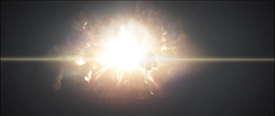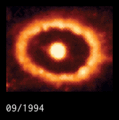Supernova: Difference between revisions
From Halopedia, the Halo wiki
NightHammer (talk | contribs) |
mNo edit summary |
||
| Line 27: | Line 27: | ||
*''[[Halo: Escalation]]'' | *''[[Halo: Escalation]]'' | ||
*''[[Halo: Nightfall]]'' {{Mo}} | *''[[Halo: Nightfall]]'' {{Mo}} | ||
==Gallery== | |||
<gallery> | |||
File:SN1987a debris evolution animation.gif|Animation of Supernova 1987a, showing stellar collapse and buildup of ejecta within the debris ring. Note that this sequence takes places over a 15-year period. | |||
</gallery> | |||
==Sources== | ==Sources== | ||
Revision as of 09:10, March 9, 2015
| There is more information available on this subject at Supernova on the English Wikipedia. |

A supernova (plural: supernovae or supernovas) is a stellar explosion. They are extremely luminous and cause a burst of radiation that may briefly outshine an entire galaxy before fading from view over several weeks or months. During this short interval, a supernova can radiate as much energy as the Sun could emit over its life span. The explosion expels much or all of a star's material at a velocity of up to a tenth the speed of light, driving a shock wave into the surrounding interstellar medium. This shock wave sweeps up an expanding shell of gas and dust called a supernova remnant.[1]
On average, supernovae occur about once every 50 years in a galaxy the size of the Milky Way and play a significant role in enriching the interstellar medium with heavy elements. Furthermore, the expanding shock waves from supernova explosions can trigger the formation of new stars.
History
In early Forerunner history, the Forerunners attempted to manipulate several stars in their region of space. They subsequently failed and caused several stars to supernova, leaving their homeworld heavily irradiated and uninhabitable.[2]
Before their defeat at the hands of the Flood, and the firing of the Halo Array, the Forerunner fleet had "the capacity to force premature stellar collapse," creating an artificial supernova, used to destroy entire star systems taken by the Flood.[3]
Another supernova occurred in 648 BCE, allegedly causing the destruction of the San'Shyuum homeworld, Janjur Qom.[4] However, it is possible that the San'Shyuum lied about the planet's destruction and many members of the Covenant doubted the San'Shyuum's claims.[5]
In the Battle of Shield World 0459 in 2531, the UNSC moved the UNSC Spirit of Fire's slipspace drive into the Apex Site of Shield World 0459 and detonated it close to the internal miniature star. The chain reaction sent the star into supernova state, obliterating the installation and the fleet of Forerunner dreadnoughts, preventing the Covenant from using it and saving humanity from total defeat and extinction.[6]
At the close of the Requiem campaign in 2558, the leader of a Covenant remnant, Jul 'Mdama, put the shield world Requiem on a collision course with the system's sun, Epoloch. When the shield world was absorbed by the sun, the star went into a supernova state and exploded, nearly destroying the UNSC Infinity which narrowly escaped the shockwave into slipspace.[7]
List of appearances
- Halo 3
- Terminals (First mentioned)
- Halo Wars (First appearance)
- Halo: Cryptum (Mentioned only)
- Halo 4
- Halo: Silentium (Mentioned only)
- Halo: Escalation
- Halo: Nightfall (Mentioned only)
Gallery
Sources
- ^ Wikipedia: Supernova
- ^ Halo: Cryptum, page 222
- ^ Halo 3, Terminal 2
- ^ Halo Encyclopedia, page 113
- ^ Halo Waypoint: Janjur Qom
- ^ Halo Wars, cutscene "One Less Sun in The Universe"
- ^ Spartan Ops, S1E10 Exodus
